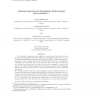Free Online Productivity Tools
i2Speak
i2Symbol
i2OCR
iTex2Img
iWeb2Print
iWeb2Shot
i2Type
iPdf2Split
iPdf2Merge
i2Bopomofo
i2Arabic
i2Style
i2Image
i2PDF
iLatex2Rtf
Sci2ools
WG
1999
Springer
1999
Springer
Finding Smallest Supertrees Under Minor Containment
The diversity of application areas relying on tree-structured data results in wide interest in algorithms which determine differences or similarities among trees. One way of measuring the similarity between trees is to find the smallest common superstructure or supertree, where common elements are typically defined in terms of a mapping or embedding. In the simplest case, a supertree will contain exact copies of each input tree, so that for each input tree, each vertex of a tree can be mapped to a vertex in the supertree such that each edge maps to the corresponding edge. More general mappings allow for the extraction of more subtle common elements captured by looser definitions of similarity. We consider supertrees under the general mapping of minor containment. Minor containment generalizes both subgraph isomorphism and topological embedding; as a consequence of this generality, however, it is NP-complete to determine whether or not G is a minor of H, even for general trees. By ...
Common Elements | Input Trees | Smallest Common Superstructure | Theoretical Computer Science | WG 1999 |
| Added | 05 Aug 2010 |
| Updated | 05 Aug 2010 |
| Type | Conference |
| Year | 1999 |
| Where | WG |
| Authors | Naomi Nishimura, Prabhakar Ragde, Dimitrios M. Thilikos |
Comments (0)

